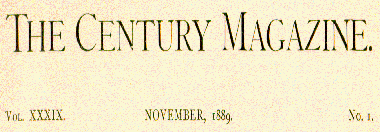By Ernest H. Crosby (1856-1907).
First appearance: The Century Magazine, November 1889.
Short short story (8 pages).
Online HERE.
Our narrator takes pains to assure us these things actually happened:
SEVERAL years have passed since the newspapers were full of the D—— murder case. It was particularly remarkable on account of the social prominence and previous high reputation of the accused and the strange circumstances which followed his trial. The story offers promising material for a penny dreadful, but I do not recall it to the attention of the public on that account. I had peculiar opportunities for knowing the alleged criminal, and he had exhibited to me, more perhaps than to any one else, the state of his mind. I then believed that I owed it to psychological science to give some report of the case, and with that intention I made some memoranda at the time. On looking over these notes I am still of the opinion that they should be published. . . .Insanity, jealousy, both—or neither? Ambiguity abounds as a man becomes obsessed with the idea that his cousin, a prominent politician and someone he sees as a rival, is deceiving the world:
. . . "He is loathsome — dishonor, meanness, sin itself . . . He is not a man; he is a fiend."His obsession will culminate in death and a bizarre court trial—but, wonders our narrator, is he really guilty of murder? And, further, could he have been justified in his hatred for his rival?
Resources:
- Crosby, an ardent admirer of Tolstoy and a vegetarian, has a rather short FictionMags list HERE.
- Also noteworthy about this issue of The Century is the first appearance of Mark Twain's A Connecticut Yankee in King Arthur's Court.
The bottom line: Nobody owns life, but anyone who can pick up a frying pan owns death.
— William S. Burroughs


No comments:
Post a Comment